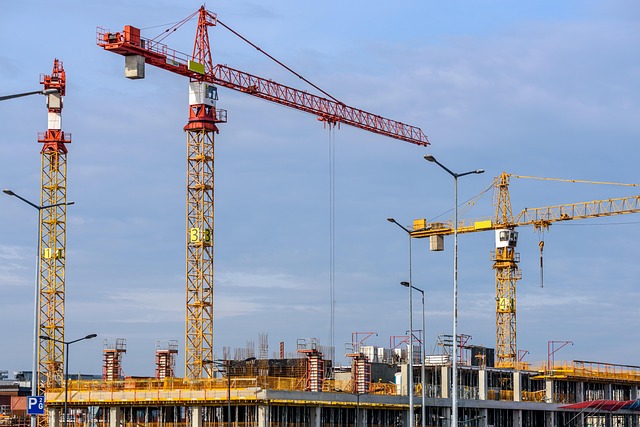Understanding Crane Operation as an Occupational Field
The field of crane operation represents a specialized sector within construction and heavy equipment industries. This occupational category requires technical expertise, safety awareness, and precision skills while typically offering compensation packages commensurate with the responsibilities involved. Examining the qualifications and responsibilities associated with crane operation can provide educational context for those researching this professional domain.

Crane operation constitutes an established occupational category within construction, manufacturing, shipping, and other industries requiring heavy lifting capabilities. Individuals in this profession operate sophisticated machines to move materials with precision and safety, contributing to various industrial processes. The field of crane operation has specific training requirements, certification standards, and occupational characteristics that can be examined from an educational perspective.
Introduction to Crane Operation as an Occupation
The field of crane operation involves the control of specialized equipment designed to lift, move, and place heavy materials and objects that would otherwise be impossible to handle manually. This occupational category spans diverse environments including construction sites, ports, manufacturing facilities, shipyards, and warehouses. The profession encompasses various specializations based on equipment type, from tower cranes used in high-rise construction to mobile cranes that provide greater flexibility in various settings.
The broader industry includes several related occupational categories. These include riggers who prepare loads, signal persons who guide operators, crane inspectors who evaluate equipment safety, and maintenance technicians who service these complex machines. Professional development in this field typically involves training as apprentices or helpers, gradually acquiring the experience and certifications associated with operator positions and potentially advancing to supervisory roles.
Working conditions in this occupation vary significantly depending on specialization and industry. Tower crane operation typically involves shifts in elevated cabs, while mobile crane work frequently requires travel between locations. The occupation often involves early mornings, occasional overtime, and sometimes challenging weather conditions, necessitating both physical stamina and mental focus.
Skills Associated with Crane Operation
The crane operation profession combines technical abilities with specific personal attributes that enable safe and effective performance. Exceptional depth perception and spatial awareness are fundamental, as the work requires accurately judging distances and clearances while maneuvering loads that may weigh several tons. Hand-eye coordination and fine motor skills allow for precise control of complex machinery, often requiring simultaneous management of multiple controls.
Technical aptitude is essential for understanding crane mechanics, load calculations, and operational limits. Mathematics skills apply when calculating load weights, counterbalance requirements, and determining safe lifting capacities. Communication skills are equally important, as coordination with ground crews through radio systems or hand signals is necessary, especially when direct visibility is limited.
Physical stamina supports the demands of long shifts, often in confined operator cabs, while maintaining unwavering concentration. Perhaps most crucial is a safety-first mindset—responsible crane operation requires understanding that decisions affect the wellbeing of everyone in the vicinity. Adaptability rounds out these skills, as the profession requires adjustment to changing weather conditions, different equipment types, and varying site requirements.
Certification and Licensing in Crane Operation
The certification process for crane operation has become increasingly standardized across the industry. In the United States, the National Commission for the Certification of Crane Operators (NCCCO) provides widely recognized credentials. OSHA regulations generally require certification when working with equipment exceeding certain capacities, typically those lifting more than 2,000 pounds.
The certification process typically involves both written and practical examinations. The written component tests knowledge of safety regulations, load calculations, site assessment, and technical specifications. The practical exam evaluates hands-on operating skills, requiring candidates to demonstrate precise control through standardized maneuvers. Most certifications remain valid for five years before requiring renewal through additional testing or continuing education.
Beyond national certifications, many states and municipalities impose additional licensing requirements. These may include medical examinations, background checks, or supplementary testing specific to local regulations. Specialized training for particular crane types or applications beyond basic certification is often required. Educational pathways include formal training through vocational schools, community colleges, or union apprenticeship programs that combine classroom instruction with supervised hands-on experience.
Compensation Structure in Crane Operation
The crane operation profession typically involves compensation reflecting the specialized skills and responsibilities required. According to industry data, entry-level positions in this field generally correspond to wages between $40,000 and $50,000 annually, while experienced professionals with specialized certifications may earn between $70,000 to $100,000 or more, depending on various factors.
Elements influencing compensation include certification level, experience, crane type specialization, industry sector, geographical location, and union membership status. Union positions often follow standardized wage scales with scheduled increases based on experience, along with comprehensive benefit packages. Non-union positions may feature performance-based incentives or different base wages depending on the employer and market conditions.
Prices, rates, or cost estimates mentioned in this article are based on the latest available information but may change over time. Independent research is advised before making financial decisions.
Beyond base salary, the occupation typically includes benefits packages that may feature health insurance, retirement plans, paid time off, and disability coverage. The profession may involve overtime opportunities that can affect annual earnings. Some employers provide additional compensation for specialized certifications, challenging work environments, or travel requirements. Professional development within this field may include supervisory roles, training or inspection positions, or transitions to equipment sales and consulting work.
Common Questions About Crane Operation as a Profession
What is the typical training duration for crane operation certification?
The educational timeline varies depending on the training path selected. Formal apprenticeship programs typically span 3-4 years, combining classroom instruction with supervised practical training. Vocational programs may be completed in 8-12 months, followed by additional experience requirements before certification eligibility. Those with relevant heavy equipment experience might qualify for accelerated programs lasting several months. Most educational pathways require accumulating a minimum number of supervised operating hours before attempting certification exams.
What physical requirements are associated with crane operation?
While not as physically demanding as some construction trades, the profession requires specific physical capabilities. Medical evaluations typically assess vision (including depth perception and peripheral vision), hearing, and general health. The ability to climb ladders and navigate tight spaces is necessary for accessing certain crane types. The work involves maintaining focus during long periods of stationary operation and managing the physical strain of precise control movements throughout shifts that can extend 8-12 hours.
Which industries utilize crane operation skills?
Construction represents a significant sector utilizing crane operation, particularly in commercial and infrastructure projects. Shipping ports and terminals require these skills for loading and unloading cargo vessels. Manufacturing facilities, especially those producing large components like aircraft parts or heavy machinery, maintain crane operations departments. Mining operations, oil and gas industries, shipyards, and specialized heavy lifting service companies also utilize these professional skills. The diversity of industries incorporating crane operation contributes to the occupation’s overall characteristics and geographic distribution.




